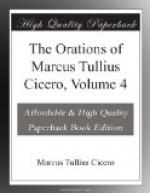short syllables and then the long one, which the ancients
consider the most musical foot of the two: I do
not object to it; though there are other feet which
I prefer. Even the spondee is not utterly to
be repudiated; although, because it consists of two
long syllables, it appears somewhat dull and slow;
still it has a certain steady march not devoid of
dignity; but much more is it valuable in short clauses
and periods; for then it makes up for the fewness
of the feet by its dignified slowness. But when
I am speaking of these feet as occurring in clauses,
I do not speak of the one foot which occurs at the
end; I add (which however is not of much consequence)
the preceding foot, and very often even the foot before
that. Even the iambic, which consists of one short
and one long syllable; or that foot which is equal
to the choreus, having three short syllables, being
therefore equal in time though not in the number of
syllables; or the dactyl, which consists of one long
and two short syllables, if it is next to the last
foot, joins that foot very trippingly, if it is a
choreus or a spondee. For it never makes any
difference which of these two is the last foot of a
sentence. But these same three feet end a sentence
very badly if one of them is placed at the end, unless
the dactyl comes at the end instead of a cretic; for
it does not signify whether the dactyl or the cretic
comes at the end, because it does not signify even
in verse whether the last syllable of all is long
or short. Wherefore, whoever said that that paeon
was more suitable in which the last syllable was long,
made a great mistake; since it has nothing to do with
the matter whether the last syllable is long or not.
And indeed the paeon, as having more syllables than
three, is considered by some people as a rhythm, and
not a foot at all. It is, as is agreed upon by
all the ancients, Aristotle, Theophrastus, Theodectes,
and Ephorus, the most suitable of all for an oration,
either at the beginning or in the middle; they think
that it is very suitable for it at the end also; in
which place the cretic appears to me to be better.
But a dochmiac consists of five syllables, one short,
two long, one short, and one long; as thus:—[)A]m[=i]c[=o]s
t[)e]n[=e]s; and is suitable for any part of the
speech, as long as it is used only once. If repeated
or often renewed it then makes the rhythm conspicuous
and too remarkable. If we use these changes,
numerous and varied as they are, it will not be seen
how much of our rhythm is the result of study, and
we shall avoid wearying our hearers.
LXV. And because it is not only rhythm which makes a speech rhythmical, but since that effect is produced also by the arrangement of the words, and by a kind of neatness, as has been said before, it may be understood by the arrangement when words are so placed that rhythm does not appear to have been purposely aimed at, but to have resulted naturally, as it is said by Crassus:—




